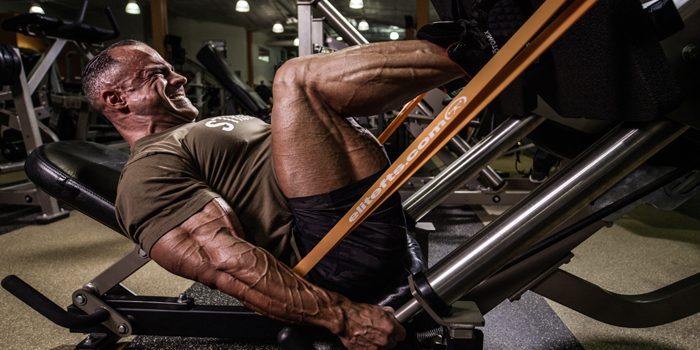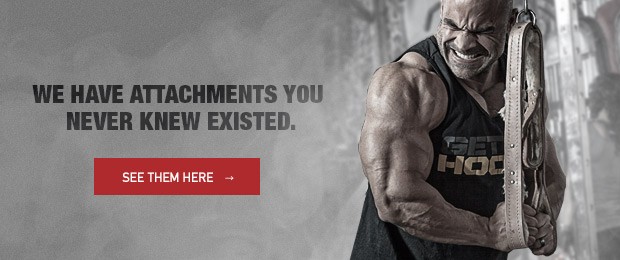
Much to the chagrin of some Brits who still email me their complaints, I no longer subscribe to high intensity training (HIT). Muscle tears, inflamed joints, a jacked up lower back, and being in my 40s helped put the nail in the HIT coffin five years ago — at least in the classic HIT sense. I say "in the classic HIT sense" because few would consider my present training methods lacking in intensity, but it certainly resembles something different than the Yates-fueled workouts of my 20s.
When you first pick up the iron, the primary parameter through which intensity is increased is weight. Sure, your form sucks and achieving the mind-muscle connection feels as foreign and elusive as attempting to harness the power of The Force from a Stars Wars movie, but you grow regardless. Untrained, virgin muscle fibers simply respond under load. Moving increasingly heavier weight from point A to B served me well until I tore my pec benching 500 pounds and blew out my lower back squatting 700.
RECENT: 7 Ways to Optimize Health
Sorry to bruise the burly bro ego, but intensity comes in more forms than how much weight you add to the bar. In fact, some intensity techniques do more for hypertrophy in a safer fashion than traditional HIT. I categorized several of my favorites under two major headings below.
Eccentric-Focused Reps
The eccentric, commonly known as the negative, portion of the rep is when the muscle being worked goes from a shortened/contracted position to an elongated position. The elongation of a muscle under load creates a significant amount of trauma, more so than the concentric portion. And more trauma, when properly supported with intra-workout nutrition such as Biotest Plazma, means more growth.
It’s claimed that the body can handle roughly 1.75-times more weight eccentrically than concentrically. So if you can bench press 225 pounds, you can theoretically lower (eccentric) 394 pounds, providing someone helped lift the weight off your chest and back into the rack. I’m not promoting bumping your one-rep max to 175% and doing negative reps, however. I simply want to harness the benefits of eccentric reps without the risk of injury. Here are three options:
Five-Second Eccentric Reps
Simply grab a weight suitable for performing 10-12 reps. This weight should be adequate for performing six reps, but with a full five-second eccentric phase. For example, let’s say you can curl a 60-pound barbell for 12 reps. Using that weight, curl the bar and flex your biceps are hard as possible in the contracted position and then slowly lower the weight for five seconds before reversing the motion and doing another rep. You will likely fail to maintain this perfect rep cadence by about the sixth rep. This is a simple, safe, and effective way to add intensity across a broad spectrum of exercises.
Eccentric Overload Reps
This method overloads the eccentric phase of the rep range with additional weight. My preferred method modulates the added resistance to match your ability as you fatigue, but it requires an experienced training partner who knows your limits. For example, let’s say you can perform 12 reps on a chest supported T-bar row with two 45-pound plates. Load the machine with 70 pounds instead of 90 pounds, perform the concentric portion of the rep, hold in the contracted position for a split second, and then have your training partner force the weight through the eccentric portion of the rep range while resisting. Your training partner can reduce the amount of added tension as you fatigue to ensure you get at least six eccentrically overloaded reps.
Banded Tension Reps
Bands add a couple different elements to otherwise standard lifts. In regard to categorizing this under the eccentric-focused rep heading, I’ll focus on forward banding vs. reverse banding. Reverse banding is helpful when training for explosiveness, but when paying particular attention to the eccentric phase of the reps, standard banding is better. Bands aid continuous muscle activation by intensifying the contraction via added resistance. A typical negative involves lowering the weight, but bands require additional resistance. My personal favorites include banded leg press, dumbbell pullovers, dumbbell press, triceps pushdowns and barbell biceps curls.
Eccentric-focused reps ramp up intensity and often reward you with a deep soreness in the target muscle group the next day. For obvious reasons, use these methods sparingly.
Extended Sets
Extending your set is an intensity technique which most often involves approaching or hitting failure on a given exercise, and then changing a parameter to allow your body to continue with the same exercise for a few more reps. It’s like taking an exercise beyond failure and then some more. It requires mental toughness to not tap out so you can grind your way to new growth. For safety reasons, I don’t recommend doing these on the big three compound barbell movements (squat, deadlift and bench press).
Drop Sets
Pretty much everyone knows of the drop set. You simply select an exercise and go to failure and then drop some weight so you can continue again to failure and extend the set. Multiple variations exist. My personal favorite is a little different than how I see most people approach a drop set. I’ll take lying leg curls as an example.
Work your way up in weight, warming up and doing sets of 8-10 reps, saving the drop set for your final working set. Let’s say you can leg curl 150 pounds for six reps before hitting failure. Your drop set would look something like this:
- 150 x 6
- Drop to 90 (40% drop) x 8
- Drop to 60 (~33% drop) x 10
As you see from the example, I prefer to drop roughly 30-40% of the weight on each drop and increase the reps. I find this method the most effective.
Rest/Pause Sets
Another widely used technique to extend a training set is the rest pause method. Evidence suggests the most significant trigger for hypertrophy is training to failure. In fact, researchers concluded training to failure was more important than the amount of weight used. Personally, this makes the rest pause technique all the more powerful.
An example of a rest-pause set for dumbbell rows might look like this:
- 120 x 10
- Rest/Pause for 10 Seconds
- 120 x 3-4 (Failure)
- Rest/Pause for 10 Seconds
- 120 x 2-3 (Failure)
The brief rest/pause allows a slight recovery to occur thereby affording you the opportunity to extend the set with the same weight for a few more reps and tap into the benefits of failure multiple times in a short period of time.
Ascending Sets
Some favor lighter weight and higher reps to achieve maximum development, while others opt for max effort, low rep schemes coupled with heavy weight. I do believe in the metabolic hormone cascade, which follows a very high rep (20-30) set on occasion, but exclusively high rep sets failed to bring me the greatest gains. Lower rep sets (six to eight reps) always seemed to garner the best results, but the risk of injury increases substantially when moving maximum pounds, as evidenced by a quad tear I suffered on leg press.
WATCH: John Meadows UGSS Presentation — Principles and Phase I
Most serious lifters are familiar with drop sets, but less often do I see people performing ascending sets. A great way to increasing training intensity and extend a set is via an ascending set after a proper warm-up. Leg press is my personal favorite.
Example: Do five reps with six plates per side. Have a training partner add a single plate to one side and do another five reps. Have a training partner add another single plate to the other side and do another five reps. Keep going in this fashion performing five reps before pausing just long enough to have a training partner add another plate as you ascend in weight until you hit failure.
Extended sets allow you to use relatively heavy weight and extend sets beyond the typical failure point, but in a safer fashion. Sprinkle these examples into your training program sparingly to ensure your CNS continues to function optimally.
My training is always evolving, as should yours. Training ruts tend to halt progress, or worse yet lead to injury. Adaptation fuels growth, but the older you get, the more you realize adaptation through heavier weight quickly runs its course. Don’t lose heart or give up training. Find new, safer ways to stimulate growth and keep training exciting.













